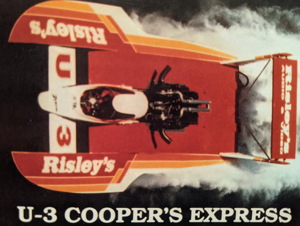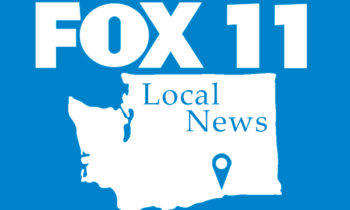
TRI-CITIES, Wash.-2024 marks the 58th time that unlimited hydroplanes will race on the Columbia River in late July.
It is also the 35th anniversary of the last time a piston-powered hydroplane won in the Tri-Cities, as Mitch Evans in the U-3 Cooper’s Express took the checkered flag, in one of the most dramatic Columbia Cup final heats ever.
The 1989 Columbia Cup came about during a period of change in the sport, as teams transitioned to both enclosed cockpits and turbine engines by the mid-1980’s.
“When a piston boat is running right, it’s like nothing else,” Mitch Evans said recently in looking back at his historic 1989 win.
In the post-World War II years the sport of hydroplane racing grew, fueled by the availability and affordability of engines.
Between 1931 and 1948 over 70,000 V-12 Allison and Rolls-Royce Merlin or Griffin piston-powered engines were manufactured for fighter planes, according to the Hydroplane and Raceboat Museum.
After World War II, the government surplussed thousands of these aircraft engines and hydroplane teams bought them up, and piston-powered boats were the racing standard until the 1980’s.
Perhaps the most revolutionary development in the history of hydroplane racing was the introduction of the turbine engine to the sport and its ultimate domination.
The Lycoming T-55 L-7 turbine engines that power a hydroplane are from Vietnam-Era Chinook helicopters. At abut 900 pounds, the engines are lighter than the piston-powered motors and are more reliable, with fewer moving parts, all while producing about 3,000 horsepower, according to H1 Unlimited.
By the late 1980’s it was clear that turbine engines would power the future of hydroplane racing, yet some race teams held out, believing piston-power could still compete, which set the stage for the 1989 Columbia Cup.
The U-3 Cooper’s Express
The father and son team of Ed Cooper Sr. and Junior formed a race team in 1985, ran the old Tempus boat in 1986 and built a new boat in 1988.
“It was at a time when unlimited hydroplane race teams started installing F-16 canopies for safety,” said Mark Evans of helping build the boat that would become the 1989 Columbia Cup winner. “I drew up some modified drawings to go by for better standards, performance and safety. Then Mitch and I built a new center section of the boat in the Chelan shop. After that we hauled it out to Cooper’s shop in Indiana so the team could install systems and finish it.”
The Cooper’s team finished the boat in time for the 1989 season and the U-3 would run with Mitch Evans in the cockpit.
According to Evans, the team had some sponsorships in 1989, but they were on a race-by-race basis, meaning the team didn’t have a sponsor at every race site.
That’s why the U-3 was simply the Cooper’s Express as boats hit the water for the 1989 Columbia Cup.
The 1989 Columbia Cup
Turbine engines may have been the future everyone in the sport of hydroplane racing saw coming, however, on Sunday, July 30, 1989, piston-powered hydroplanes let out a final roar of thunder.
“That was a crazy one,” Mitch Evans recently said, looking back on the 1989 race 35 years later.
The sport of hydroplane racing is often a game of attrition, with boats taking a beating from the river or accidents. By the time of the final on Sunday afternoon in the Tri-Cities several boats had to bow out.
“We ran pretty consistent throughout the day with some fourths and fifths to get into the final,” Evans said.
The Circus Circus stayed on the dock with a rudder problem. The Mr. Pringles was out after a near-flip and the Winston Eagle caught on fire before the final, keeping three turbine powerhouses on the shoreline.
That left the turbine-powered Miss Budweiser driven by Tom D’Eath and five piston-powered boats, including the Cooper’s Express in the final.
The Oh Boy! Oberto and Miss Tri-Cities boats broke down in the final and did not finish the race.
Suddenly it was a four boat race between the Miss Budweiser, Miss Madison Mazda, Cooper’s Express and Pietro’s Pizza.
As the field dwindled it left the door open for the consistent racing that Evans and the Cooper’s Express had displayed all day.
Evans and the U-3 were running in third place when D’Eath in the Miss Budweiser was penalized a lap after swinging out wide and washing-out the Miss Madison Mazda, causing them to lose power.
In 1989 two-way radio communications were not yet standard in hydroplane racing equipment and drivers often had to rely on flags while out on the race course, according to Evans, which is why he didn’t know he was now leading the Columbia Cup.
“It was basically just the Bud with Tommy D’Eath and us,” Evans said.
Evans was second on the water, but first in the race as the Pietro’s Pizza was still running, but was out of contention and the Budweiser had to complete an extra lap.
“I knew Tommy and the Budweiser had an extra lap because they didn’t give them the checkered flag,” Evans said. “We made a good start, ran a good race and had some luck. We came in second and got first.”
A piston-powered hydroplane has not won the Columbia Cup since Evans’ win in the Cooper’s Express, and 35 years later, the excitement hasn’t faded.
“All these years later, it’s always fun to just be able to run well,” Evans said. “What still stands out to me is coming into the pits, there were a ton of people on the dock cheering, just going crazy. It was a great moment, lots of fun.”
A piston-powered legacy
Within a few years of the 1989 Columbia Cup, the U-3 was the only remaining piston-powered boat in the unlimited fleet, however, that victory inspired the team to keep racing.
“We saw it coming,” Evans said of the sports wholesale shift to turbine engines. “We consulted and talked about switching, but we kept thinking this is going to work with a turbine engine.”
If it was going to work, if the Cooper’s team was going to be competitive, it meant building a better boat.
In hydroplane racing a lighter boat means faster speeds, but also the potential for damage. According to Evans the boat that won the 1989 Columbia Cup was a light boat.
The Cooper’s team built a new boat that was sturdy, but not particularly fast affectionately called “Miss Tubby” in 1997, followed by another in 2002.
“The third boat was built using Budweiser molds and was made of carbon-fiber,” Evans said.
The third time was the charm and Evans and the Cooper team achieved their greatest success on the water with their third boat.
In 2003 Evans and the Cooper team won the Gold Cup in Detroit, as well races in Evansville and San Diego.
The U-3 kept piston-powered hydroplane racing alive and was a fan favorite on the unlimited circuit through the 2023 season.
The Tri-City Water Follies Apollo Columbia Cup can be seen on SWX on Sunday, July 28 from 10 a.m. to 5 p.m.


